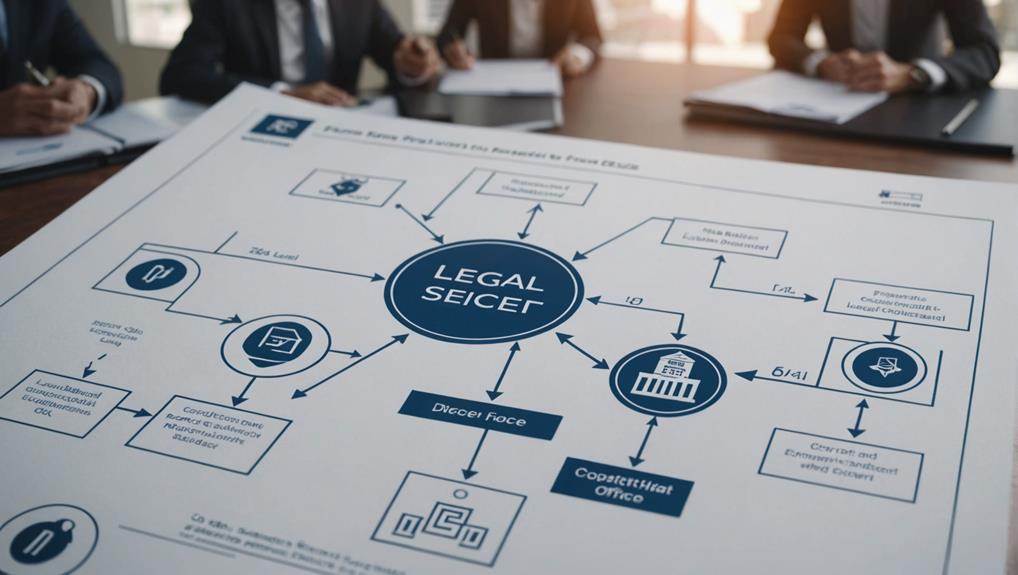Understanding the Legal Obligations for Insider Trading Disclosure Through SEC Form 4

Insider trading disclosures through SEC Form 4 play a crucial role in maintaining transparency and accountability in the stock market. Insiders, such as directors and officers who own more than 10% of shares in a company, are required to report significant stock transactions within two business days. This requirement stems from the Securities Exchange Act of 1934, designed to ensure fair practices and market integrity. By promptly disclosing their transactions, insiders contribute to a level playing field for all investors and help prevent any potential market manipulation.
Non-compliance with filing Form 4 can have serious consequences, including severe civil or criminal penalties. Such penalties not only tarnish one's reputation but also have financial implications. Therefore, understanding and adhering to these reporting obligations are essential for upholding corporate governance standards and fostering trust within the financial community. By fulfilling these obligations, insiders contribute to a more reliable and secure financial ecosystem, benefiting all stakeholders involved.
To further safeguard market integrity and ensure compliance with insider trading regulations, it is crucial for insiders to stay informed about their reporting responsibilities and the implications of failing to file Form 4 in a timely manner. By staying proactive and diligent in meeting these requirements, insiders can uphold ethical standards, promote investor confidence, and contribute to a more transparent and trustworthy financial marketplace.
Key Takeaways
Insiders are mandated to promptly submit Form 4 following any significant stock transactions, ensuring timely disclosure to the Securities and Exchange Commission (SEC) and the public. The disclosure requirement applies to directors, officers, and shareholders holding over 10% of company stock, aiming to enhance transparency in the financial markets.
Failure to adhere to the Form 4 filing deadline can lead to severe civil and criminal repercussions, underscoring the critical importance of compliance with insider trading regulations. By submitting accurate and timely Form 4 reports, insiders uphold market integrity, prevent potential conflicts of interest, and mitigate the risk of unfair trading practices.
Form 4 serves as a cornerstone for maintaining investor confidence by providing insight into insider transactions, fostering trust in the market's fairness and promoting a level playing field for all investors. It is a vital tool in safeguarding against illicit activities and preserving the integrity of the financial system.
Overview of SEC Form 4
SEC Form 4 is a crucial filing that insiders must submit within two business days to report significant changes in their holdings of company stock. This requirement applies to directors, officers, or shareholders with more than a 10% stake in the company. By promptly disclosing their equity transactions, these insiders uphold transparency and accountability in the securities market, as mandated by the Securities Exchange Act of 1934 and the Investment Company Act of 1940.
The filing deadline for SEC Form 4 is a critical aspect that insiders must adhere to. Failure to meet this two-day window can result in serious consequences, such as civil or criminal actions. By revealing their connections to the company and providing details of their stock transactions, insiders help maintain a fair and level playing field for all investors. Once submitted, these reports become public record, enabling greater scrutiny and fostering trust in the market.
SEC Form 4 plays a vital role in monitoring insider trading activities. Compliance with these regulations goes beyond mere adherence—it contributes to the cultivation of an environment characterized by integrity and innovation in the financial sector. Directors and officers who follow these guidelines play a key role in promoting a transparent financial ecosystem that benefits all participants involved.
Key Legal Requirements
Insiders must strictly adhere to legal requirements to ensure timely and accurate disclosure of their trades. SEC Form 4 plays a pivotal role in this process, mandating that insiders like executives and major shareholders report their transactions in company shares within two business days of a significant event. This tight deadline promotes transparency and upholds market integrity.
Our legal obligations related to insider trading are governed by stringent securities laws. Any failure to comply, such as missing the deadline for submitting Form 4 filings, can result in serious civil or criminal consequences. Compliance isn't just about following rules; it's about building trust and fostering accountability in the financial markets.
The disclosure enabled by Form 4 filings offers the public crucial access to information on insider transactions. This transparency is vital for maintaining investor trust and ensuring a fair playing field for all market participants. Therefore, understanding these legal requirements isn't only a regulatory necessity but also a fundamental aspect of our compliance strategy.
Who Must File

Directors, officers, and beneficial owners holding more than 10% of a company's stock are legally obligated to submit Form 4 to the SEC. This requirement ensures transparency in their trading activities and plays a crucial role in upholding insider trading laws. By disclosing material changes in ownership of equity securities, these individuals contribute to a more transparent and trustworthy financial ecosystem.
Those classified as Section 16 filers, such as directors and officers with policy-making functions, must clearly outline their relationship to the company and provide details of any insider transactions. This obligation goes beyond mere regulatory compliance; it serves as a commitment to transparency that fosters innovation and trust in the marketplace. The table below summarizes the key filing requirements:
| Role | Filing Requirement | Implication |
|---|---|---|
| Directors | Submit Form 4 for significant changes | Ensures transparency |
| Officers | Disclose insider transactions | Supports market integrity |
| Beneficial Owners | Report ownership exceeding 10% | Ensures regulatory compliance |
Non-compliance with these filing obligations can result in severe consequences, including civil or criminal actions. By adhering to these rules, we not only abide by legal standards but also contribute to a fair and transparent market environment. Let's embrace these responsibilities, recognizing their role in fostering a culture of accountability and innovation.
Timing of Filings
When discussing the timing of filings, it's crucial to highlight the SEC's strict requirement that Form 4 filings be submitted within two business days of an insider trading transaction. This rule is in place to ensure transparency and guarantee that any significant changes in beneficial ownership are promptly disclosed to the public.
Failure to meet this deadline can lead to serious consequences, including potential civil or criminal actions. It's essential for insiders to adhere to this timeline to maintain compliance with SEC regulations and uphold the integrity of the market.
Reporting Deadline Requirements
Meeting the SEC's two-business-day deadline for submitting Form 4 filings is essential to comply with regulations and maintain transparency regarding insider trading activities. SEC Form 4 aims to ensure that any significant transaction involving company insiders is reported promptly. This filing deadline isn't just a requirement; it's a fundamental aspect of regulatory adherence that upholds the integrity of the market.
Timely disclosures through Form 4 are crucial to keeping shareholders and the public informed about insider transactions. These transactions refer to substantial changes in ownership that could impact investor decisions. Failing to meet the filing deadline can result in severe consequences, such as facing civil or criminal actions. Therefore, adhering to the two-business-day timeframe is critical.
In today's fast-paced information age, the Form 4 filing deadline is more than a mere regulatory obligation—it is a vital component of fostering trust and transparency. By meeting these deadlines, we contribute to a market environment that prioritizes accuracy and timely information. Non-compliance not only exposes one to regulatory penalties but also undermines the credibility of the entire market.
Transaction Reporting Timelines
Understanding the transaction reporting timelines, especially the strict two-business-day requirement for filing Form 4, is crucial for upholding regulatory compliance and promoting transparency in insider trading activities. Adhering to our reporting obligations under SEC rules is essential in the realm of insider trading.
Form 4 mandates prompt disclosure within two business days of any significant transaction involving the company's shares. This rapid filing deadline ensures transparency and accountability, which are vital for stakeholders and market integrity.
Timely submission of Form 4 isn't just a procedural step; it's a fundamental aspect of compliance. Failure to meet this filing deadline can result in severe consequences, such as civil or criminal actions. Directors, officers, and individuals with over 10% beneficial ownership must promptly report any changes, upholding the stringent standards of regulatory oversight.
Penalties for Non-Compliance

Not meeting SEC Form 4 filing deadlines can result in significant civil and criminal penalties. Failure to comply with these deadlines can have serious consequences. The SEC requires insiders to disclose any material changes in beneficial ownership promptly to maintain market transparency. Violating these rules can lead to substantial financial penalties.
Our legal responsibility is to report any significant changes within two business days. Neglecting this duty can result in civil lawsuits, monetary fines, and potential sanctions from the SEC. The regulatory framework surrounding SEC Form 4 is designed to uphold the integrity of the market, and failing to adhere to filing deadlines undermines this objective.
Consequences for non-compliance extend beyond monetary fines. There's a risk of damaging our reputation, which can be equally detrimental in the long term. The SEC is vigilant in enforcing insider trading disclosure rules, swiftly addressing any breaches. Non-compliance not only jeopardizes our financial status but also undermines our credibility.
Complying with SEC Form 4 filing requirements isn't just about avoiding penalties; it's about promoting transparency and trust in our financial markets.
Steps to File SEC Form 4
To file SEC Form 4, we must access the EDGAR system promptly and submit the form electronically within two business days of the transaction. This crucial filing is vital for fulfilling our legal obligations under the Securities and Exchange Commission's regulations. Let's simplify the process for a smooth electronic submission.
Firstly, gather all essential details about the material transaction to ensure accurate disclosure. Then, navigate to the EDGAR system and utilize the provided filing link for Form 4. Input the data meticulously to guarantee complete transparency, as the SEC mandates this for insider trading activities.
Let's refer to the following table for a quick overview:
| Step | Action | Importance |
|---|---|---|
| 1. Prepare | Gather transaction details | Ensure accurate disclosure |
| 2. Access EDGAR | Use filing link | Navigate to the correct form |
| 3. Enter Data | Input transaction information | Fulfill legal obligations |
| 4. Submit Form | Complete electronic submission | Achieve timely filing |
| 5. Confirm | Verify submission status | Ensure compliance with SEC rules |
Relationship to Form 3

Understanding the connection between Form 3 and insider trading disclosures is essential in grasping the disclosure requirements for insiders.
Form 3 acts as the initial ownership report that new insiders must file with the Securities and Exchange Commission (SEC) within ten days of acquiring insider status. This form sets the foundation for subsequent filings such as Form 4, which details changes in ownership.
Initial Ownership Reporting
When insiders have changes in their ownership of company stock, they're required to file SEC Form 4 to report these transactions. Unlike Form 3, which focuses on initial ownership, Form 4 deals with subsequent changes in ownership. This form is crucial for maintaining transparency and trust in the financial markets. By promptly and accurately reporting these transactions, insiders help ensure a fair and regulated trading environment.
Form 4 provides detailed information about the nature of the transaction, including the date of the transaction, the type of transaction (such as a purchase or sale), and the number of shares involved. This disclosure is essential for investors and regulatory bodies to monitor insider trading activities and ensure compliance with securities laws.
Insiders must file Form 4 within two business days of the transaction date, emphasizing the importance of timely reporting. Failure to meet this deadline can lead to penalties and legal repercussions. By adhering to the requirements of Form 4, insiders contribute to market integrity and investor confidence.
Filing Deadlines Explained
Let's delve into the crucial filing deadlines for Forms 3 and 4, which insiders must follow to comply with securities laws. When an individual becomes an insider, they must submit Form 3 within ten days. This form records their initial stock acquisitions and establishes a foundation for their beneficial ownership.
However, the real challenge arises with Form 4, which monitors changes in beneficial ownership resulting from significant transactions. Insiders are required to file Form 4 within two business days of any material transaction. This swift reporting ensures transparency and enables the market to remain informed about insider activities.
Failure to meet these filing deadlines isn't simply an administrative error; it can have serious repercussions, including legal actions. Timely submission of Form 4 is crucial for upholding compliance and avoiding legal consequences.
Recognizing the interplay between these forms is crucial. Form 3 sets the groundwork, while Form 4 propels the narrative forward. Both are indispensable tools in our commitment to transparency and regulatory adherence in the realm of insider trading.
Abiding by these deadlines isn't just about obeying regulations; it's about nurturing trust and honesty in the financial sector.
Comparison to Form 4
Form 3 and Form 4 play distinct but complementary roles in monitoring insider trading activities. Form 3 focuses on the initial acquisition of company stock by insiders, while Form 4 documents significant changes in ownership thereafter.
Insiders must file Form 3 within ten days of becoming an insider, while Form 4 must be submitted within two business days of any material transactions. This swift reporting requirement emphasizes the importance of timely and comprehensive disclosure to uphold market transparency effectively.
Form 3 serves as the foundation by outlining the initial equity holdings of insiders under the Securities Exchange Act of 1934 and the Investment Company Act of 1940. In contrast, Form 4 captures subsequent alterations, such as additional purchases, sales, or other significant transactions that impact an insider's ownership.
These disclosures enable stakeholders to monitor ongoing insider trading activities and evaluate potential market implications.
Non-compliance with Form 4's disclosure obligations can result in severe consequences, including civil lawsuits or criminal penalties. This underscores the critical need for accurate and prompt reporting to ensure regulatory compliance.
Understanding the connection between Form 3 and Form 4 allows for a better grasp of the comprehensive regulatory framework crafted to maintain transparency and fairness in equity markets. The collaboration between initial and continuous disclosures cultivates an environment of trust and responsibility among all market participants.
Relationship to Form 5
Insiders are mandated to utilize Form 5 to report transactions that were either overlooked or considered exempt from the immediate reporting obligations stipulated by Form 4. This form plays a crucial role in ensuring that individuals engaged in insider trading adhere to the stringent disclosure requirements set forth by the SEC. In instances where transactions have slipped through the cracks of Form 4, Form 5 steps in to guarantee comprehensive disclosure, thereby rectifying any oversights. It must be filed within 45 days following the conclusion of the company's fiscal year, providing insiders with an opportunity to rectify any inaccuracies or omissions from previous filings.
The timely submission of Form 5 is paramount, as failure to do so can result in penalties and regulatory actions by the SEC. This underscores the significance of adhering to deadlines and maintaining accuracy in reporting. The table below outlines key details regarding Form 5:
| Aspect | Details | Importance |
|---|---|---|
| Filing Deadline | Within 45 days after the fiscal year ends | Compliance with SEC regulations |
| Covered Transactions | Transactions missed or exempt from Form 4 reporting | Ensuring comprehensive disclosure |
| Consequences of Non-Compliance | Penalties and SEC enforcement actions | Upholding legal and financial integrity |
Real-World Examples

In the case of Elon Musk's Form 4 filing for Tesla Inc., the disclosure requirements regarding insider trading are exemplified. On May 4, 2021, Elon Musk revealed the acquisition of 9,436,723 shares at various prices through his Form 4 submission to the SEC. This instance showcases the necessity for insiders, like Musk, to report their transactions to ensure transparency and compliance with insider trading regulations.
Elon Musk's Form 4 specifically outlined his connection to Tesla Inc. as a 10% owner and CEO, clearly establishing his insider status. The details in the Form 4 included the type of security, which was common stock, the acquisition date, and the total number of shares acquired.
This level of disclosure is crucial for upholding investor confidence by offering a transparent view of ownership changes within the company.
Benefits of Compliance
Ensuring compliance with insider trading disclosure rules brings substantial benefits to both the market and individual companies. Diligently filing SEC Form 4 enhances transparency and accountability, crucial components in maintaining a fair trading environment. This transparency reassures investors that they've equal access to vital information, thereby boosting investor confidence.
Adhering to compliance standards isn't just about avoiding potential legal actions; it's about actively contributing to the integrity of the market. Proper insider trading disclosure helps prevent unfair trading practices that could distort market operations. This integrity is essential for maintaining a level playing field where innovation and fair competition can flourish.
Compliance also upholds regulatory obligations and supports robust corporate governance standards. Following these legal requirements demonstrates our commitment to ethical business practices, essential for long-term success. Strong corporate governance not only fosters a culture of responsibility but also attracts investors seeking reliable and accountable companies.
In essence, prioritizing SEC Form 4 compliance reinforces the foundations of market integrity, ensures transparency, and promotes accountability, all of which are indispensable for fostering a trustworthy and innovative marketplace.
Additional Resources

We've compiled a list of essential resources to assist you in understanding and meeting the requirements for disclosing insider trading activities. Accessing the right materials is crucial for staying informed about regulatory changes and ensuring timely and accurate filings.
The SEC website serves as the main source of compliance information. You can find the Small Entity Compliance Guide on the website, which simplifies insider trading regulations and provides information on important compliance dates, especially those effective after April 1, 2023. Forms 4 and 5, necessary for filings, can also be easily accessed on the SEC website.
If you have specific inquiries, the Division of Corporation Finance at the SEC is an invaluable resource. They offer tailored guidance on insider trading policy disclosures to address your unique circumstances. Foreign private issuers should pay attention to the updated Form 20-F requirements to ensure compliance with the new disclosure standards.
Below is a summary of key resources for insider trading disclosure compliance:
- SEC Website: Central hub for compliance information and filing forms
- Small Entity Compliance Guide: Detailed explanations of insider trading regulations
- Division of Corporation Finance: Assistance with insider trading disclosure inquiries
- Compliance Dates: Key dates for new disclosure requirements post-April 2023
- Forms 4 and 5: Essential forms for insider trading disclosure
- Form 20-F Requirements: Specific requirements for foreign private issuers
Frequently Asked Questions
How to Understand SEC Form 4?
To grasp the essence of SEC Form 4, we need to delve into the insider benefits, stock options, and transaction categories it encompasses. This form plays a crucial role in disclosing changes in ownership of company stock by insiders, shedding light on their trading activities and ownership stakes.
One key aspect to keep an eye on when reviewing SEC Form 4 is the potential for amendments that may indicate filing errors or updates to previously reported information. Monitoring these amendments ensures accuracy in the disclosure of insider transactions and holdings.
It is also essential to adhere to reporting deadlines set by the Securities and Exchange Commission to maintain transparency and compliance with regulatory requirements. Failing to meet these deadlines can result in penalties and legal repercussions for the individuals involved.
Understanding the trading permissions and ownership thresholds tied to equity incentives is vital when analyzing SEC Form 4. Insider transactions are closely monitored to prevent illegal trading practices and ensure fairness in the market.
What Is SEC Rule Form 4?
Is SEC Rule Form 4 the key to unlocking transparency? This rule requires executive officers to report details such as trading periods, equity securities, beneficial ownership, and transaction types within specific reporting deadlines. By imposing these strict requirements, SEC Form 4 ensures regulatory compliance and promotes insider reporting.
SEC Form 4 plays a crucial role in enhancing transparency within companies. This mandatory disclosure of changes in ownership of company stock by insiders allows investors and the general public to have a clearer understanding of the transactions taking place within a company. By providing this information promptly and accurately, Form 4 helps to maintain trust and accountability in the financial markets.
The significance of SEC Form 4 cannot be understated. It not only holds executive officers accountable for their trading activities but also serves as a tool for detecting potential insider trading or market manipulation. By requiring timely and detailed reporting, Form 4 contributes to the overall integrity and efficiency of the financial system.
What Are the SEC Requirements for Insider Trading?
We need to follow the SEC's rules and requirements for insider trading, specifically regarding the completion of SEC Form 4. This form is necessary for insiders to disclose any changes in their ownership of company stock. By adhering to these regulations, we can avoid trading penalties, maintain financial integrity, and uphold good corporate governance practices. The enforcement of SEC rules also plays a crucial role in promoting transparency within our company's operations.
When Must Form 4 a Be Filed With the Sec?
Form 4 must be filed with the SEC within two business days to meet filing deadlines. Reporting individuals must disclose beneficial ownership, transaction types, and exempt transactions via electronic submission to avoid late filings, compliance penalties, and ensure robust audit trails for transparency. Late filings can result in regulatory consequences, so it is essential to adhere to the two-day filing requirement to stay compliant with SEC regulations. By promptly submitting Form 4, insiders can provide accurate and timely information about changes in ownership of company stock, enhancing transparency and accountability in the financial markets.
Conclusion
Understanding and complying with SEC Form 4 is crucial for individuals engaged in insider trading.
Surprisingly, in 2022, the SEC imposed penalties exceeding $1.6 billion for violations related to disclosure.
Adhering to these regulations isn't just about avoiding fines; it's also about promoting transparency and building trust in the financial markets.
Staying informed and diligent ensures that our trading activities are lawful and transparent, maintaining integrity in the marketplace.






